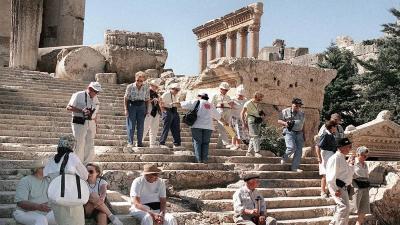The significant increase in the number of arrivals in Lebanon during the Eid al-Adha holiday, along with the high demand for reservations for summer events, has revived hopes tied to the sparkle of tourism activity and its vital contribution to restoring a positive growth trajectory for the GDP. This comes after nearly nine months of frustrating conditions that followed the outbreak of the Gaza war and its extensions to the ongoing clashes along the southern border.
Contrary to the fears that circulated earlier this month regarding reports and analyses about an imminent expansion of Israeli attacks towards the interior, Minister of Public Works and Transport, Ali Hamieh, revealed that the average daily arrivals in Beirut through "Rafic Hariri International Airport" has risen to 14,000 and is continuously increasing. Similarly, Jean Aboud, head of the "Travel and Tourism Agencies," confirmed that "the Israeli threats of a potential strike in mid-month had negative repercussions, but the indicators have risen again, with booking occupancy rates increasing to between 90 and 95 percent." It is noted that expatriate Lebanese and those working abroad make up the vast majority of arrivals.
Before this new surge at the onset of the summer season, the number of arrivals in Lebanon had decreased by 5.37 percent, amidst a recorded decline in the number of flights by 9.34 percent, and a drop in the number of travelers through "Beirut Airport" by 6.84 percent during the first five months of the current year, with 2.29 million travelers compared to 2.46 million travelers during the same period last year. This decline was attributed to the tensions stemming from the Gaza war along the southern borders of Lebanon.
The tourism sector, with inflows exceeding 5 billion dollars annually based on trends recorded in the past two years, ranks as the second most crucial source of revenue after remittances from expatriates and workers abroad, which officially amount to around 7 billion dollars. Together, they represent more than half of the national output, which has slid from its peak of approximately 55 billion dollars to less than 22 billion dollars due to the explosion of the financial and monetary crises nearly five years ago.
With the loss incurred from active seasonal tourism periods, particularly during the previous Christmas holidays, followed by the skiing season, and then Easter and Eid al-Fitr, a report from "Bank of Beirut" estimates that the lost tourism revenues during the first six months of the outbreak of the war have exceeded one billion US dollars, based on a 24 percent decline in the average number of tourists, considering that the average expenditure of a tourist in Lebanon is around 3,000 US dollars.
War Damages
Documented analyses locally and internationally indicate that the Lebanese economy is among the most affected regional economies due to the war; direct impacts are evident in the south, translating into significant human and material losses along the border area in general. Meanwhile, indirect effects are reflected in security and economic repercussions on total investments, amid uncertainty regarding the outlook on one hand, and the war's impact on the performance of the tourism sector, which had begun to show tangible signs of recovery before the conflict, on the other hand.
The tourism sector gains exceptional importance and added value amid the contraction of investment activity in Lebanon and the new effects of the war on investors' and businessmen's decisions. According to a banking analysis, a state of caution and anticipation prevails, given the uncertainty of the security situation within the country, which negatively affects macroeconomic and financial prospects in Lebanon. It is noted that the ratio of investment size to GDP stands at a low level of less than 10 percent, one of the lowest historically in the country, and among the lowest in emerging markets, indicating a notable weakness in capital formation overall.
Bad Scenarios
In this context, based on the importance of the tourism sector in Lebanon, which accounts for about 26 percent of current account revenues, "Standard & Poor’s" conducted computational tests aimed at assessing the net impact of the possibility of Lebanon suffering a loss of 10, 30, or 70 percent of tourism revenues on the economy.
According to the first scenario, "the agency" found that if tourism revenues decline by 10 percent due to the conflict, the real economy in Lebanon would shrink by 3 percent. The second scenario, assuming a 30 percent drop in tourism revenues, would result in a 10 percent contraction in real GDP. Meanwhile, the third and worst scenario assumes a 70 percent decrease in tourism revenues, leading to a 23 percent contraction in the real economy of Lebanon.




